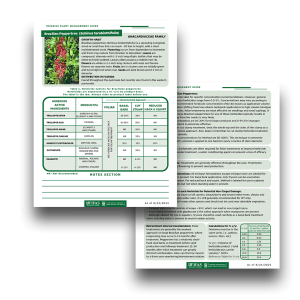After several discussions with invasive plant management groups in Florida, it was recognized that many land managers often lack access to resources about the technical aspects of herbicides for invasive plant treatments. Therefore, a brief but detailed summary was needed for many, common invasive plants. These guides bring together herbicide recommendations for invasive plants in an accessible format and several important considerations for herbicide selection. It is important to note that the herbicide label is the law, and professionals must read the product label before use.
We intend to build a library of management guides for a wide variety of common invasive terrestrial plant species. Currently, management guides have been created for eight species (see list below) and eight more are in production.
- Arrowhead vine (Syngodium podophyllum)
- Brazilian peppertree (Schinus terebinthifolia)
- Camphor tree (Cinnamomum camphora)
- Earleaf acacia (Acacia auriculiformis)
- Golden pothos (Epipremnum pinnatum v. Aureum)
- Java plum (Syzygium cumini)
- Leadtree (Leucaena leucocephala)
- Small-leaved climbing fern AKA Old World climbing fern (Lygodium microphyllum)
How are the guides set up?

The invasive plant management guides are downloadable one-pagers (front and back) for plant management professionals to reference in the office or out in the field. Each guide is tailored for the target invasive plant species, with key herbicide treatment options and important considerations when utilizing these tools in the field.
The front of each guide provides a description of the specific plant species’ growth habits and distribution in Florida. Then, a table of herbicide active ingredients and products is provided to describe common concentrations and application techniques that are used to successfully manage the target plant. A notes section is included for professionals to use while planning and conducting treatments. On the back, professionals will find important treatment considerations depending on the chosen approach. These considerations include:
- Additional herbicide notes related to Table 1.
Always read this section after consulting with the table for important details. - Adjuvant performance
- Seasonality of treatment
- Hydrologic challenges
- Non-target effects
- Retreatment intervals
- Calculations for % volume to volume, with a reference table.
The guides are available for download on the UF/IFAS CAIP website in the management guide section on our resources page. If you have any questions about these guides, please email Dr. Stephen Enloe, professor and invasive plant Extension specialist.
This project was funded by the Florida Fish and Wildlife Commission.
Follow UF/IFAS CAIP on Instagram, Facebook, and Twitter. Subscribe for more blogs like this one. UF/IFAS Center for Aquatic and Invasive Plants. Turning Science Into Solutions.
Did you find this post helpful? Click the heart below!
Source: UF/IFAS Pest Alert
Note: All images and contents are the property of UF/IFAS.



